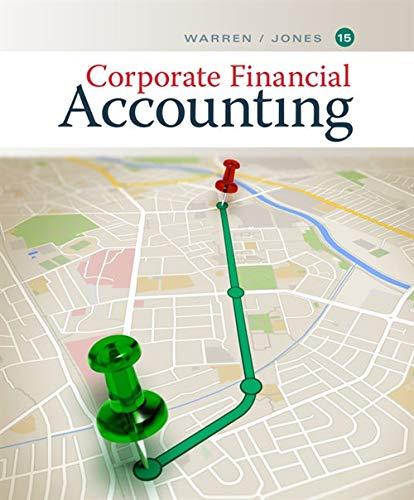Question
Perpetual inventory usingFIFO Beginning inventory, purchases, and sales for Item Zeta9 are as follows: Date Line Item Description Value Oct. 1 Inventory 200 units at
Perpetual inventory usingFIFO
Beginning inventory, purchases, and sales for Item Zeta9 are as follows:
Date | Line Item Description | Value |
Oct. 1 | Inventory | 200 units at $40 |
Oct. 7 | Sale | 180 units |
Oct. 15 | Purchase | 180 units at $45 |
Oct. 24 | Sale | 150 units |
Assuming a perpetual inventory system and using the first-in, first-out (FIFO) method, determine (a) the cost of goods sold on October 24 and (b) the inventory on October 31. a. Cost of goods sold on October 24 b. Inventory on October 31
Perpetual inventory usingFIFO
Beginning inventory, purchases, and sales for Item Zeta9 are as follows:
Date | Line Item Description | Value |
Oct. 1 | Inventory | 200 units at $40 |
Oct. 7 | Sale | 180 units |
Oct. 15 | Purchase | 180 units at $45 |
Oct. 24 | Sale | 150 units |
Assuming a perpetual inventory system and using the first-in, first-out (FIFO) method, determine (a) the cost of goods sold on October 24 and (b) the inventory on October 31. a. Cost of goods sold on October 24 b. Inventory on October 31
Perpetual inventory usingFIFO
Beginning inventory, purchases, and sales for Item Zeta9 are as follows:
Date | Line Item Description | Value |
Oct. 1 | Inventory | 200 units at $40 |
Oct. 7 | Sale | 180 units |
Oct. 15 | Purchase | 180 units at $45 |
Oct. 24 | Sale | 150 units |
Assuming a perpetual inventory system and using the first-in, first-out (FIFO) method, determine (a) the cost of goods sold on October 24 and (b) the inventory on October 31. a. Cost of goods sold on October 24 b. Inventory on October 31
Periodic inventory usingFIFO,LIFO, andweighted average cost methods
The units of an item available for sale during the year were as follows:
Date | Line Item Description | Units | Cost per Unit | Amount |
Jan. 1 | Inventory | 15 units | at $43 | $645 |
Aug. 13 | Purchase | 5 units | at $44 | 220 |
Nov. 30 | Purchase | 6 units | at $45 | 270 |
Available for sale | 26 units | $1,135 |
There are 16 units of the item in thephysical inventory at December 31.
The periodic inventory system is used. Determine the inventory cost using the (a) first-in, first-out (FIFO) method; (b) last-in, first-out (LIFO) method; and (c) weighted average cost method(round per-unit cost to two decimal places and your final answer to the nearest whole dollar).
Line Item Description | Amount |
a. First-in, first-out (FIFO) method | $ |
b. Last-in, first-out (LIFO) method | $ |
c. Weighted average cost method | $ |
Lower-of-cost-or-market method
On the basis of the following data, determine the value of the inventory at the lower-of-cost-or-market by applying lower-of-cost-or-market to each inventory item, as shown inExhibit 10.
Commodity | Inventory Quantity | Cost per Unit | Market Value per Unit (Net Realizable Value) |
JFW1 | 6,330 | $10 | $11 |
SAW9 | 1,140 | 36 | 34 |
a. $
Effect of inventory errors
During the taking of itsphysical inventory on December 31, 20Y3, Waterjet Bath Company incorrectly counted its inventory as $728,660 instead of the correct amount of $719,880. Indicate the effect of the misstatement on Waterjet Bath's December 31, 20Y3, balance sheet and income statement for the year ended December 31, 20Y3. Also record the amount of each overstatement or understatement. Enter all amounts as positive numbers.
Line Item Description | Financial Statement | Understated or Overstated | Amount |
Inventory | Balance SheetIncome Statement | OverstatedUnderstatedNo effect | $ |
Current assets | Balance SheetIncome Statement | OverstatedUnderstatedNo effect | $ |
Total assets | Balance SheetIncome Statement | OverstatedUnderstatedNo effect | $ |
Owner's Equity | Balance SheetIncome Statement | OverstatedUnderstatedNo effect | $ |
Cost of goods sold | Balance SheetIncome Statement | OverstatedUnderstatedNo effect | $ |
Gross profit | Balance SheetIncome Statement | OverstatedUnderstatedNo effect | $ |
Net income | Balance SheetIncome Statement | OverstatedUnderstatedNo effect | $ |
- Inventory turnover and days' sales in inventory
Financial statement data for years ending December 31 for Tango Company follow:
Line Item Description | 20Y7 | 20Y6 |
Cost of goods sold | $3,465,675 | $3,849,655 |
Inventories: | ||
Beginning of year | 737,300 | 715,400 |
End of year | 803,000 | 737,300 |
a.Determine the inventory turnover for 20Y7 and 20Y6.Round your answers to one decimal place.
Line Item Description | 20Y7 | 20Y6 |
Inventory turnover | fill in the blank 1 of 2 | fill in the blank 2 of 2 |
b.Determine the days' sales in inventory for 20Y7 and 20Y6. Use 365 days a year.Round your answers to one decimal place.
Line Item Description | 20Y7 | 20Y6 |
Days' sales in inventory | fill in the blank 1 of 2days | fill in the blank 2 of 2days |
c.Are the changes in inventory turnover and the number of days' sales in inventory from 20Y6 to 20Y7 favorable or unfavorable?
Step by Step Solution
3.30 Rating (144 Votes )
There are 3 Steps involved in it
Step: 1
a Inventory turnover for 20Y7 Cost of goods sold Average inventory 3465675 737300 803000 ...
Get Instant Access to Expert-Tailored Solutions
See step-by-step solutions with expert insights and AI powered tools for academic success
Step: 2

Step: 3

Ace Your Homework with AI
Get the answers you need in no time with our AI-driven, step-by-step assistance
Get Started


